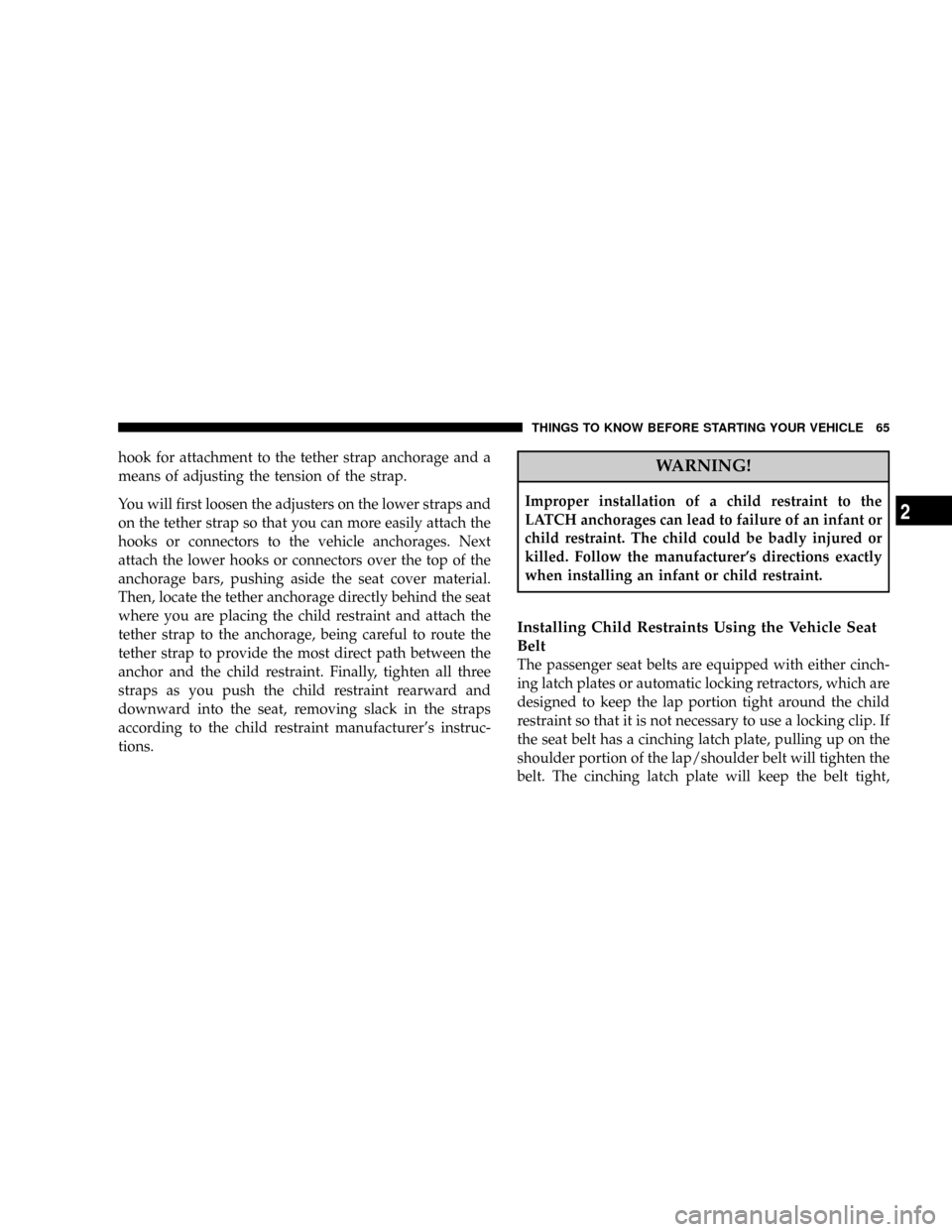2008 JEEP GRAND CHEROKEE lock
[x] Cancel search: lockPage 54 of 490

²It is not advisable to drive your vehicle after the
airbags have deployed. If you are involved in another
collision, the airbags will not be in place to protect you.
WARNING!
Deployed airbags and seat belt pretensioners cannot
protect you in another collision. Have the airbags,
seat belt pretensioners, and seat belt retractor assem-
bly, replaced by an authorized dealer as soon as
possible.
Enhanced Accident Response Feature
If the airbags deploy after an impact and the electrical
system remains functional, vehicles equipped with
power door locks will unlock automatically. The hazard
lights will flash and the fuel will be cut off to the engine.
In addition, after the vehicle has stopped moving, the
interior lights will illuminate to aid visibility and remain
lit until the ignition switch is turned off.
NOTE:The interior lights can only be deactivated if the
key is removed from the ignition switch or the vehicle is
driven.
54 THINGS TO KNOW BEFORE STARTING YOUR VEHICLE
Page 56 of 490

block for blown fuses. Refer to ªFuse Panelº in Section 5
of this manual. See your dealer if the fuse is good.
Event Data Recorder (EDR)
In the event of an accident, your vehicle is designed to
record up to 5-seconds of specific vehicle data parameters
(see the following list) in an event data recorder prior to
the moment of airbag deployment, or near deployment,
and up to a quarter second of high-speed deceleration
data during and/or after air bag deployment or near-
deployment. EDR data are ONLY recorded if an airbag
deploys, or nearly deploys, and are otherwise unavail-
able.
NOTE:
²A near-deployment event occurs when the airbag
sensor detects severe vehicle deceleration usually in-
dicative of a crash, but not severe enough to warrant
airbag deployment.
²Under certain circumstances, EDR data may not be
recorded (e.g., loss of battery power).
In conjunction with other data gathered during a com-
plete accident investigation, the electronic data may be
used by DaimlerChrysler Corporation and others to learn
more about the possible causes of crashes and associated
injuries in order to assess and improve vehicle perfor-
mance. In addition to crash investigations initiated by
DaimlerChrysler Corporation, such investigations may
be requested by customers, insurance carriers, govern-
ment officials, and professional crash researchers, such as
those associated with universities, and with hospital and
insurance organizations.
In the event that an investigation is undertaken by
DaimlerChrysler Corporation (regardless of initiative),
the company or its designated representative will first
obtain permission of the appropriate custodial entity for
the vehicle (usually the vehicle owner or lessee) before
56 THINGS TO KNOW BEFORE STARTING YOUR VEHICLE
Page 60 of 490

Here are some tips for getting the most out of your child
restraint:
²Before buying any restraint system, make sure that it
has a label certifying that it meets all applicable Safety
Standards. The manufacturer also recommends that
you try a child restraint in the vehicle seats where you
will use it before you buy it.
²The restraint must be appropriate for your child's
weight and height. Check the label on the restraint for
weight and height limits.
²Carefully follow the instructions that come with the
restraint. If you install the restraint improperly, it may
not work when you need it.
²Except for the second row center seating position, all
passenger seat belts are equipped with cinching latch
plates. The second row center position has an auto-
matic locking retractor. Both types of seat belts aredesigned to keep the lap portion tight around the child
restraint so that it is not necessary to use a locking clip.
If the seat belt has a cinching latch plate, pulling up on
the shoulder portion of the lap/shoulder belt will
tighten the belt (the cinching latch plate will keep the
belt tight, however, any seat belt system will loosen
with time, so check the belt occasionally and pull it
tight if necessary). For the second row center seat belt
with the automatic locking retractor, pull the belt from
the retractor until there is enough to allow you to pass
through the child restraint and slide the latch plate
into the buckle. Then, pull the belt until it is fully
extracted from the retractor. Allow the belt to return to
the retractor, pulling on the excess webbing to tighten
the lap portion about the child restraint. For additional
information, refer to9Automatic Locking Mode9ear-
lier in this section.
²In the rear seat, you may have trouble tightening the
lap/shoulder belt on the child restraint because the
60 THINGS TO KNOW BEFORE STARTING YOUR VEHICLE
Page 65 of 490

hook for attachment to the tether strap anchorage and a
means of adjusting the tension of the strap.
You will first loosen the adjusters on the lower straps and
on the tether strap so that you can more easily attach the
hooks or connectors to the vehicle anchorages. Next
attach the lower hooks or connectors over the top of the
anchorage bars, pushing aside the seat cover material.
Then, locate the tether anchorage directly behind the seat
where you are placing the child restraint and attach the
tether strap to the anchorage, being careful to route the
tether strap to provide the most direct path between the
anchor and the child restraint. Finally, tighten all three
straps as you push the child restraint rearward and
downward into the seat, removing slack in the straps
according to the child restraint manufacturer's instruc-
tions.WARNING!
Improper installation of a child restraint to the
LATCH anchorages can lead to failure of an infant or
child restraint. The child could be badly injured or
killed. Follow the manufacturer's directions exactly
when installing an infant or child restraint.
Installing Child Restraints Using the Vehicle Seat
Belt
The passenger seat belts are equipped with either cinch-
ing latch plates or automatic locking retractors, which are
designed to keep the lap portion tight around the child
restraint so that it is not necessary to use a locking clip. If
the seat belt has a cinching latch plate, pulling up on the
shoulder portion of the lap/shoulder belt will tighten the
belt. The cinching latch plate will keep the belt tight,
THINGS TO KNOW BEFORE STARTING YOUR VEHICLE 65
2
Page 66 of 490

however, any seat belt system will loosen with time, so
check the belt occasionally and pull it tight if necessary.
For seat belts having an automatic locking retractor, pull
the belt from the retractor until there is enough to allow
you to pass through the child restraint and slide the latch
plate into the buckle. Then, pull the belt until it is all
extracted from the retractor. Allow the belt to return to
the retractor, pulling on the excess webbing to tighten the
lap portion about the child restraint. Refer to ªAutomatic
Locking Modeº earlier in this section.
In the rear seat, you may have trouble tightening the
lap/shoulder belt on the child restraint because the
buckle or latch plate is too close to the belt path opening
on the restraint. Disconnect the latch plate from the
buckle and twist the short buckle-end belt several times
to shorten it. Insert the latch plate into the buckle with the
release button facing out.If the belt still can't be tightened, or if by pulling and
pushing on the restraint loosens the belt, you may need
to do something more. Disconnect the latch plate from
the buckle, turn the buckle around, and insert the latch
plate into the buckle again. If you still can't make the
child restraint secure, try a different seating position.
To attach a child restraint tether strap:
Route the tether strap over the seat back and attach the
hook to the tether anchor located on the back of the seat.
For the outboard seating positions, route the tether over
the head rests, and attach the hook to the tether anchor
located on the back of the seat.
66 THINGS TO KNOW BEFORE STARTING YOUR VEHICLE
Page 74 of 490

NTo Vary The Speed Setting...............137
NTo Accelerate For Passing...............137
mElectronic Brake Control System............138
NABS (Anti-Lock Brake System)............138
NTCS (Traction Control System)............139
NBAS (Brake Assist System)...............140
NERM (Electronic Roll Mitigation)..........141
NESP (Electronic Stability Program).........142
NTSC (Trailer Sway Control)..............146
NHSA (Hill Start Assist) (4WD Models With
NV245 Two±Speed Transfer Case Only)......147
NHDC (Hill Descent Control) (4WD Models
With NV245 Two±Speed Transfer Case Only) . . 149NESP/BAS Warning Lamp And ESP/TCS
Indicator Light.......................151
mRear Park Assist SystemÐ If Equipped.......152
NRear Park Assist Sensors................152
NRear Park Assist Warning Display.........153
NEnable/Disable The Rear Park Assist System . . 155
NService The Rear Park Assist System........155
NCleaning The Rear Park Assist System......156
mRear Camera Ð If Equipped...............156
NTurning The Rear Camera On............156
NTurning The Rear Camera Off............157
mOverhead Console......................157
NCourtesy/Reading Lights................158
74 UNDERSTANDING THE FEATURES OF YOUR VEHICLE
Page 79 of 490

WARNING!
Vehicles and other objects seen in the passenger side
convex mirror will look smaller and farther away
than they really are. Relying too much on your
passenger side convex mirror could cause you to
collide with another vehicle or other object. Use your
inside mirror when judging the size or distance of a
vehicle seen in the passenger side convex mirror.
Some vehicles will not have a convex passenger side
mirror.
Exterior Mirrors Folding Feature
All exterior mirrors are hinged and may be moved either
forward or rearward to resist damage. The hinges have
three detent positions; full forward, full rearward, and
normal.
Driver's and Front Passenger Outside Automatic
Dimming Mirror Ð If Equipped
If your vehicle is equipped with a outside automatic
dimming mirrors, they will operate when the inside
automatic dimming mirror is on. The outside mirrors
operate off the inside mirror switch and will automati-
cally adjust for annoying headlight glare when the inside
mirror does.
Power Remote Control Mirrors Ð If Equipped
The power mirror switch is located on the driver's door
trim panel next to the power door lock switch. A rotary
knob selects the left mirror, right mirror, or off position.
UNDERSTANDING THE FEATURES OF YOUR VEHICLE 79
3
Page 111 of 490

4 - Way Passenger's Power Seat Ð If Equipped
The front passenger's power seat switches are located on
the outboard side of the passenger seat lower side trim.
The bottom switch controls forward/rearward adjust-
ment. The top switch controls the seatback recline adjust-
ment.
NOTE:The 4 - way seat does not have an up/down
adjustment.
Head Restraints
Head restraints can reduce the risk of whiplash injury in
the event of impact from the rear. Adjustable head
restraints should be adjusted so that the upper edge is as
high as practical. The head restraints have a locking
button which must be pushed in to lower the head
restraint to all positions. The restraints may be raised
without pushing in the button.
Front Heated SeatsÐIf Equipped
Heated seats provide comfort and warmth on cold days
and can help soothe sore muscles and backs. The heaters
provide the same heat level for both cushion and back.
The front driver and passenger seats are heated. The
controls for each heater are located near the bottom
Adjustable Head Restraints
UNDERSTANDING THE FEATURES OF YOUR VEHICLE 111
3